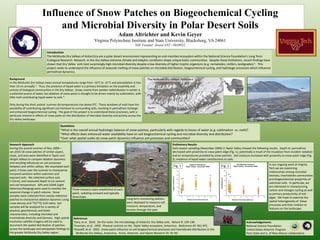
Altrichter, Geyer, Barrett VT Research Day Poster 2010
- 1. Influence of Snow Patches on Biogeochemical Cycling and Microbial Diversity in Polar Desert Soils Adam Altrichter and Kevin Geyer Virginia Polytechnic Institute and State University, Blacksburg, VA 24061 NSF Funded: Award ANT - 0838922 Introduction The McMurdo Dry Valleys of Antarctica are a polar desert environment representing an end‐member ecosystem within the National Science Foundation’s Long Term Ecological Research Network. In the Dry Valleys extreme climate and edaphic conditions shape unique biotic communities. Despite these limitations, recent findings have shown that Dry Valley soils host surprisingly high microbial diversity despite a low diversity of higher trophic organisms (e.g. nematodes, rotifers, tardigrades) 1. This project seeks to understand the influence of seasonal melting of snow patches on microbial distribution, biogeochemical cycling, and hydrologic processes which influence permafrost dynamics. Background In the McMurdo Dry Valleys mean annual temperatures range from ‐16°C to ‐21°C and precipitation is less than 10 cm annually 2. Thus, the presence of liquid water is a primary limitation on the assembly and activity of biological communities in the Dry Valleys. Snow, mainly from aeolian redistribution in winter is a potential source of water, but ablation of snow packs is thought to be driven mainly by sublimation, with little melt contributing liquid water to soils 3. Only during the short austral summer do temperatures rise above 0°C. These windows of melt have the possibility of contributing significant soil moisture to surrounding soils, resulting in permafrost recharge and enhanced biogeochemical cycling. The goal of this project is to understand these processes, with a particular interest in effects of snow packs on the distribution of microbial diversity and activity across the Dry Valley landscape. Questions *What is the overall annual hydrologic balance of snow patches, particularly with regards to losses of water (e.g. sublimation vs. melt)? *What effects does enhanced water availability have on soil biogeochemical cycling and microbial diversity and distribution? *Over what spatial scales do snow patch dynamics influence soil processes and communities? Research Approach Preliminary Results During the austral summer of Nov. 2009 – Early season sampling (November 2009) in Taylor Valley showed the following results. Depth to permafrost Jan.2010 18 snow patches of similar aspect, decreased with proximity to snow patch edge (Fig. 1), potentially a result of the insulation from incident radiation slope, and area were identified in Taylor and and air temperatures provided by snow patches. Soil moisture increased with proximity to snow patch edge (Fig. Wright Valleys to compare ablation dynamics 2), evidence of liquid water contributions to soils. and resulting influences on soil processes In our ongoing work at Virginia between and within valleys. We resampled each Fig. 1 Fig. 2 Tech we are examining patch 3 times over the summer to characterize relationships among microbial temporal variation within subnivian and biomass, invertebrate communities exposed soils. We collected surface soils and biogeochemical properties of (<10cm), and measured depth to ice cement subnivian soils. In particular, we and soil temperature. GPS and LIDAR (Light are interested in characterizing Detection/Ranging) were used to monitor the Three transects were established at each carbon and nitrogen cycling as well seasonal change in patch volume. Snow patch, radiating outward and typically as primary productivity of soil samples were collected from nearby reference downslope. Long term monitoring stations algae. We hope to examine the patches to characterize ablation dynamics using were deployed to measure soil spatial heterogeneity of these snow density and 18O/16O; D/H ratios. Soil moisture, temperature, and processes and their relation to samples will be analyzed for a variety of tension through the year. features on the landscape. physical, geochemical, and biotic characteristics, including microbial and invertebrate diversity and biomass. High spatial References resolution satellite imagery will be used to 1Cary, et al. 2010. On the rocks: the microbiology of Antarctic Dry Valley soils. Nature 8: 129‐138. Acknowledgements document the spatial distribution of patches 2Fountain, et al. 1999. Physical controls on the Taylor Valley ecosystem, Antarctica. BioScience 49: 961‐971. National Science Foundation across the landscape and extrapolate findings to 3Gooseff, et al. 2003. Snow‐patch influence on soil biogeochemical processes and invertebrate distribution in the United States Antarctic Program the greater McMurdo Dry Valley region. McMurdo Dry Valleys, Antarctica. Arctic, Antarctic, and Alpine Research 35: 91‐99. Penn State and U. of New Mexico collaborators
